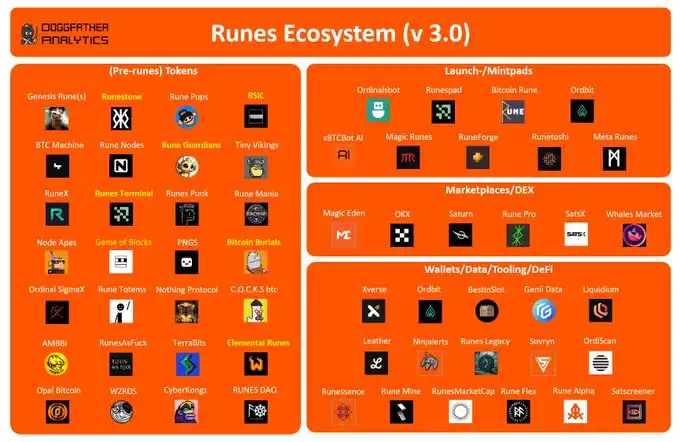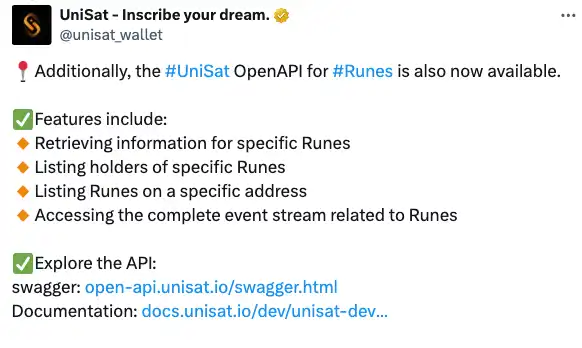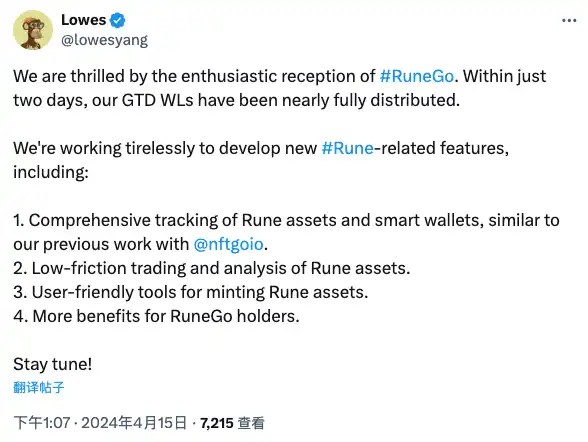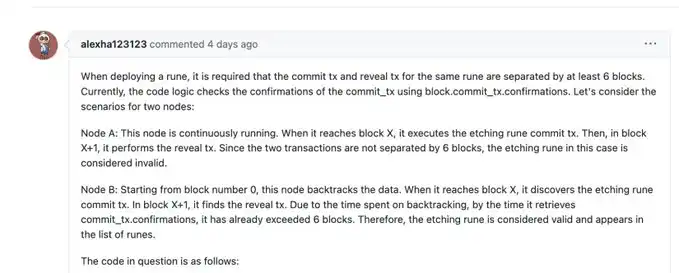It is hard to imagine that an ecosystem that has not yet launched its mainnet already has assets worth nearly US$1 billion and more than 20 infrastructure platforms.
Since the official version of the Runes protocol has not yet been released, there are currently no official Runes runes on the market; many projects still exist in the form of Bitcoin NFTs. With the final launch of the Runes protocol, it is expected that these projects will be converted into official runes through airdrops or 1:1, thus officially joining the Runes ecosystem.
Among them, the project with the highest market value is Runestone, with a market value of up to 640 million US dollars. The floor price once soared to 0.074 BTC, surpassing BAYC and becoming the second largest project in the NFT market. In addition, users who participated in the pre-mining of Bitcoin Runes tokens in the early stage have obtained considerable benefits. The buyer price of RSIC on the over-the-counter OTC platform whales.market is mainly concentrated at 0.01u, corresponding to a total market value of 210 million US dollars. Before the halving, early users can easily earn up to 10,000 US dollars.
It is no exaggeration to say that no other Bitcoin ecological protocol is more popular than Runes. BlockBeats found that in addition to pre-sold Runes mining projects such as Runestone and RSIC, the biggest driving force behind the Runes ecological boom is undoubtedly its sound infrastructure support.
More than 20 infrastructure and
In the Bitcoin ecosystem, especially in the early "gold mining" stage, owning a full Bitcoin node often means that you can significantly increase your profit potential and "eat meat". However, for most ordinary users who only "drink soup", the cost of building a full node is too high and the operation is complicated. Therefore, many people prefer to use the services of third-party proxy platforms, which are also sufficient in terms of functions.
During the period when the Ordinals protocol was popular, the minting platforms on the market were mainly concentrated in a few companies such as UniSat and OKX Web3 wallet, and at most there were only five or six. According to statistics from BlockBeats and supplementary information from the community, in the Runes protocol, which has not yet been launched on the mainnet, there are nearly 20 infrastructure platforms that provide minting, trading and other services. Among these numerous minting platforms, there are many new faces and old players in the industry.

Image source: Doggfather
OKX is ready to go, UniSat is late but here
Since March last year, the rapid development of the Bitcoin ecosystem has led to the emergence of billions of dollars in assets and the establishment of more than 20 infrastructure platforms. In this context, OKX and UniSat have become key players, and their dynamics and influence in the market are worth exploring.
From responding quickly to market changes to implementing strategic deployment, it took OKX only a week or two to decide to join the Bitcoin ecosystem. After months of preparation and accumulation, OKX has found a breakthrough for growth in this new track. As the Bitcoin ecosystem continues to heat up, OKX has become the "biggest winner" in this wave of enthusiasm with its smooth wallet products.
At present, when people in the community mention CEX trading platforms and Bitcoin ecology, the first thing that comes to mind is OKX. From Ordinals to BRC20, to ARC20 and the current Runes protocol, OKX's Web3 wallet has always been one of the first platforms to provide support.
According to Jason Wang, head of OKX Web3 Wallet, on social media, the development and testing process of Runes went very smoothly , with significant improvements in security and service stability, which made the entire team very excited. They have been researching and preparing for Runes for more than half a year, and now they can finally let users experience the charm of Runes.

Bitcoin ecosystem science blogger Bitlili also revealed that during his contact with OKX Web3, he could feel their tension and excitement during the development of Runes.
On the other hand, although UniSat is one of the earliest infrastructures in the Bitcoin ecosystem, it seems to be a little slow in responding to the Runes protocol. After the release of BRC-20, when the Bitcoin ecosystem just "emerged" last year, many traditional players were dismissive of this "rough imitation of ERC-20". UniSat is the first platform to integrate and access BRC-20 on a large scale, occupying most of the market before OKX entered the market.
Although the Runes protocol could have been UniSat's home turf, they were late to the party, not announcing support for Runes until April 5, with plans to launch the Runes engraving service and trading market in mid-April.
It can be seen that since this year, UniSat's focus has been on Ordinals, or more precisely Brc20, from the Jubilee upgrade of Ordinals to the development of Cursed Inscriptions, and then to the most influential support for 5-byte BRC20. It seems that it is intentionally helping to reduce the impact of the Runes protocol on Brc20.
However, UniSat is late but it is here. Currently, it has stated on social platforms that it has supported the Runes testnet. In addition, the UniSat OpenAPI for Runes is now available, with functions including: Retrieving information about specific Runes; Listing the holders of specific Runes; Listing the Runes on a specific address; Accessing the complete event stream related to Runes.

Re-employment of familiar faces
NFTGo was originally positioned as an NFT aggregation platform that provides market data analysis and trading functions. It is equipped with a series of powerful tools and functions, including market analysis, real-time listings, scarcity assessment, whale tracking, monitoring lists, auction calendars and trading aggregators, to help users discover, trade and manage NFT assets.
Founded in 2021, NFTGo is not only a one-stop NFT data analysis platform, it also provides users with a variety of NFT solutions including data analysis, transaction aggregation and asset management, and launched data API and aggregator API. In April last year, NFTGo completed a strategic financing of US$4 million, with additional investment from Qiming Venture Partners and Hash Global. New investors include 500 Global, Skyland Ventures, and personal investment from Liang Xinjun, co-founder of Fosun Group, and a former Binance executive.

Recently, Lowes, the founder of NFTGo, announced on social media that they not only launched the NFT project RuneGo, but also actively integrated it into the Runes ecosystem and developed new features related to it. This includes comprehensive tracking of Rune assets and smart wallets, similar to the tools they previously developed for NFTGo, as well as providing low-friction transactions and analysis of rune assets, user-friendly casting tools, etc. It is reported that RuneGo holders will enjoy additional benefits.
In addition, GeniiData is also worth mentioning, a platform focusing on cross-chain data analysis and API factory, featuring high performance, data reliability and wide coverage. It provides professional tools for personal data studios to discover, verify and build Web3 solutions through blockchain analysis. For enterprises, GeniiData is an incubator for decentralized applications, providing access to comprehensive on-chain data APIs.
Since the rise of the Bitcoin ecosystem, there are very few platforms that access Bitcoin chain data, and GeniiData has done this more frequently. The price and market data of BRC-20 tokens can often be obtained through GeniiData, including capturing the real-time minting of popular inscriptions and NFTs (such as Ordinals heat map, wallet statistics), and it is also the first native inscription data platform to provide an exclusive viewing page for Merlin Chain.
Later, as the team developed, GeniiData naturally launched the minting function and more minting projects. Recently, GeniiData also completed the minting of its own platform NFT "Feeling Good" project. Similar to RuneGo, users who own "Feeling Good" NFT will enjoy fee discounts in the future minting process.

It is worth mentioning that according to Bitri's tweet , GeniiData reported a major bug to Casey some time ago . Regarding the severity of this bug, Casey's original words were "This would have been pretty devastating if it hadn't been fixed before launch." (If it hadn't been fixed before Runes went online, it would be a devastating problem).

In the communication with BlockBeats, Bitlili also mentioned: "GeniiData has done in-depth research on Runes, and they should be quite thorough in this technical field."
Bot "not acclimatized"
During the recent market preheating of the Foundry platform, BlockBeats can also see some new faces appearing in the market, such as the Bot tool. This is the first time that a Bot has appeared in the Bitcoin ecosystem, and it often appears in the context of "as a backup plan when the Foundry platform website crashes."
Many people are still looking forward to bots, but the community's acceptance is mixed, and not all community members buy into it. Since the transaction form of the Bitcoin network is different from that of EVM, the possibility of loopholes in the code design has not been verified. Some community members even bluntly said that "bots on Bitcoin are a false demand" and "after the Runes mainnet is launched, the probability of the casting platform webpage crashing is low."
After asking Bitlili for scientific knowledge, BlockBeats found that the webpage crashes during some recent NFT sales were mainly because some activities did not require high gas fees. You only needed to click to submit the order and pay a small amount of gas to successfully purchase it. This method is called "locking the order." When the activity is free or the cost is very low, many studios will deploy scripts to automatically participate, resulting in instantaneous high visits and click traffic. In this case, the webpage may crash.
However, in the Runes ecosystem, all orders will be submitted to the memory pool and sorted and confirmed according to the gas fees paid. Transactions with high gas fees will be confirmed first, while transactions with low gas fees may be postponed to subsequent blocks for confirmation, which is similar to the mechanism of snapping up BRC-20.
“After the mainnet goes online, the gas fee rate may be very high, but even under this pressure, the nodes that are affected are mainly those that process and broadcast transactions, such as memspace and quicknode, and the possibility of the front-end web page crashing is very small.” Based on Bitlili’s past experience, she made some conclusions.
In this context, the construction of Bot in the Bitcoin ecosystem may encounter some obstacles and appear to be somewhat "unsuitable for the local environment", but BlockBeats will continue to observe and report on its subsequent development.
The GAS game is about to begin
After BlockBeats conducted an in-depth observation of the Runes-related infrastructure currently on the market, it was found that these platforms tend to provide one-stop services .
Users can conveniently perform various operations in the entire Runes ecosystem, from minting to querying progress, counting transaction amounts, tracking wallets and participating in trading markets, etc. These functions complement each other at the code design level . This one-stop service trend not only provides great convenience for users, but also improves the efficiency of the entire ecosystem and user participation. With the continuous improvement and optimization of these infrastructures, we expect the Runes ecosystem to attract more participants.
In addition, observing the current market dynamics, we can see that infrastructure platforms are preheating the market by issuing NFTs to attract and retain the first wave of user groups . These early users are not only the core target customers for the future development of the platform, but these NFTs are also designed as a special credential that symbolizes their early support and trust in the platform. This strategy not only helps build user loyalty, but also provides a way for the platform to directly interact with its target customer base.
In the market, Bitlili recommended some mining platforms that she favors to BlockBeats: "For the first level, I recommend GeniiData, UniSat, iDclub and OKX; for the second level, I recommend Unicross."
As for which foundry platform will eventually have the largest market share, "the actual foundry experience, interaction, service fee costs, etc. of each company will only be known when the official product is halved. Now we can only make guesses based on past experience and public information, which is not very accurate," Bitili told BlockBeats .
After all, the user's body is the most honest.






